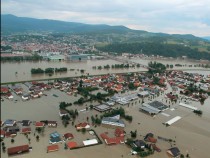
© Peter Kallus
So-called hundred year floods occur repeatedly in ever shorter intervals. Aside from the visible damage caused by water, an invisible danger often arises that continues to linger even long after buildings have dried out: leaked contaminants that intrude deeply into the construction materials of buildings. Products of the chemical industry, animal carcasses and faeces, and most of all, heating oil spills can make it necessary to rehabilitate entire neighbourhoods or even partially or completely demolish and rebuild them afterwards.
Even after drying out and renovation, oil spots returned to the surface in a number of homes: traces of heating oil that had seeped deeply into the pores of the brick- and blockwork penetrated the new render layers from within. The simplest kind of prevention is to completely avoid using oil to heat buildings and, for instance, to switch to natural gas. In addition, the most cost-efficient way of floodproofing new buildings is to decide against creating a basement.
The rehabilitation of flood damages is only the last element in a chain of causes and measures, ranging from regional planning to flood protection for entire cities with to construction-based protective methods for individual buildings. Among scientists, levees are not considered the solution, but simply a means to relegate the problem further downriver.
Even after drying out and renovation, oil spots returned to the surface in a number of homes: traces of heating oil that had seeped deeply into the pores of the brick- and blockwork penetrated the new render layers from within. The simplest kind of prevention is to completely avoid using oil to heat buildings and, for instance, to switch to natural gas. In addition, the most cost-efficient way of floodproofing new buildings is to decide against creating a basement.
The rehabilitation of flood damages is only the last element in a chain of causes and measures, ranging from regional planning to flood protection for entire cities with to construction-based protective methods for individual buildings. Among scientists, levees are not considered the solution, but simply a means to relegate the problem further downriver.






